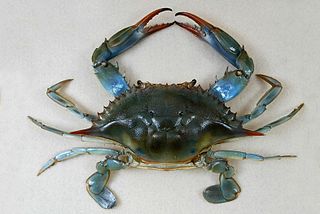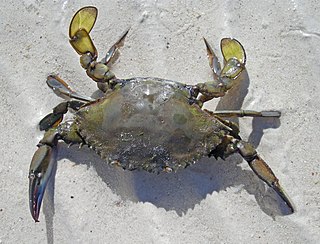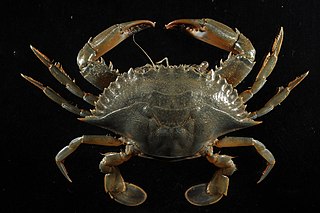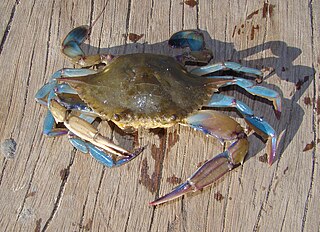
Callinectes sapidus, the blue crab, Atlantic blue crab, or, regionally, the Maryland blue crab, is a species of crab native to the waters of the western Atlantic Ocean and the Gulf of Mexico, and introduced internationally.

Callinectes is a genus of crabs, containing 16 extant species, including the Atlantic blue crab, C. sapidus:

Portunus pelagicus, also known as the blue crab, blue swimmer crab, blue manna crab and flower crab is a species of large crab found in the Indo-Pacific, including off the coasts Indonesia, Malaysia, Cambodia, Thailand, the Philippines, and Vietnam; and in the intertidal estuaries around most of Australia and east to New Caledonia.

Portunidae is a family of crabs which contains the swimming crabs. Its members include many well-known shoreline crabs, such as the blue crab and velvet crab. Two genera in the family are contrastingly named Scylla and Charybdis; the former contains the economically important species black crab and Scylla paramamosain.

Callinectes arcuatus is a species of swimming crab in the genus Callinectes that lives along the Pacific coast of Central America.

Crab meat or crab marrow is the meat found within a crab, or more specifically in the leg of a crab. It is used in many cuisines around the world for its soft, delicate and sweet flavor. Crab meat is low in fat and provides approximately 340 kilojoules (82 kcal) of food energy per 85-gram (3 oz) serving. Brown crab, blue crabs, blue swimming crabs, and red swimming crabs are among the most commercially available species of crabmeat globally.
Hematodinium perezi is a pathogenic dinoflagellate parasite that infects crustaceans, including the Blue Crab and Norway Lobster and has been observed to have a significant impact on crustacean fisheries. Infected crustaceans frequently show signs of weakness and lethargy, and often die due to stress-related handling from fishing as well as metabolic exhaustion due to reduced feeding. This parasite is known to be quite transmissible between various crustacean hosts.

Callinectes bellicosus is a species of swimming crab in the genus Callinectes. They are native to warm waters and shorelines in Mexico. They are prepared and eaten in the same manner as blue crabs.

Callinectes bocourti is a species of swimming crab. Its native range extends from Jamaica and Belize south to Brazil, but it has been found as a nonindigenous species as far north as North Carolina. This crab has a light brown shell with red spots and markings on it, and red claws and legs. C. bocourti is edible and has been the subject of small-scale fishery.

Callinectes danae is a species of swimming crab. The carapace is olive-brown and up to 5.8 cm (2.3 in) long; the walking legs are blue. The species is common in Brazil and the West Indies.

Callinectes marginatus, commonly known as the sharptooth swimcrab or marbled swimcrab, is a species of swimming crab in the family Portunidae.

Callinectes ornatus is a species of swimming crab in the genus Callinectes. It can be distinguished from the closely related Atlantic blue crab by the presence of six frontal teeth on the carapace, compared with only four for C. sapidus. C. ornatus is also smaller, at a maximum carapace width of only 93 millimetres (3.7 in), compared to 230 mm (9.1 in) in C. sapidus, and is therefore not commercially exploited.

Callinectes rathbunae is a species of swimming crab. It occurs in warm coastal waters of Mexico. The species is not used as food, but is kept in laboratories for research. Young crabs can range from 17–64 millimetres (0.67–2.52 in) in size. The specific epithet rathbunae commemorates Mary J. Rathbun.

Crab fisheries are fisheries which capture or farm crabs. True crabs make up 20% of all crustaceans caught and farmed worldwide, with about 1.4 million tonnes being consumed annually. The horse crab, Portunus trituberculatus, accounts for one quarter of that total. Other important species include flower crabs, snow crabs (Chionoecetes), blue crabs, edible or brown crabs, Dungeness crab, and mud crabs, each of which provides more than 20,000 tonnes annually.

Callinectes similis, sometimes called the lesser blue crab or dwarf crab, is a West Atlantic species of blue crab. It was described by Austin B. Williams in 1966.
Hematodinium is a genus of dinoflagellates. Species in this genus, such as Hematodinium perezi, the type species, are internal parasites of the hemolymph of crustaceans such as the Atlantic blue crab and Norway lobster. Species in the genus are economically damaging to commercial crab fisheries, including causing bitter crab disease in the large Tanner or snow crab fisheries of the Bering Sea.
C. exasperatus may refer to a few different species. The specific epithet exasperatus means 'roughened.'














